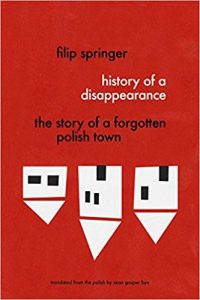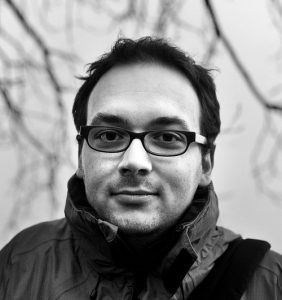by KARAH MITCHELL
Filip Springer, History of a Disappearance: The Story of a Forgotten Polish Town
Originally published 2011. English translation by Sean Gaspar Bye, April 2017. Restless Books: Brooklyn, NY, pp 320
Imagine a medieval town in the countryside of Lower Silesia, perched upon a mountain in the Sudetes range. It’s the twelfth century, and miners roam about, digging into the mountainside for precious minerals. Now watch the town pass through history, appearing and reappearing over the span of more than seven hundred years. From 1512 until about 1532, under the guidance of Dippold von Burghaus, “nearly 160 mineshafts and drifts are dug in the mountainside” (14). In 1634, in the midst of the Thirty-Years War, troops fighting for the Habsburgs decimate the town, forcing survivors to flee to the woods for safety. Citizens return back to ruined Kupferberg, continuing to mine it for its riches, continuing to live their lives both above and beneath the ground. In 1824, the town disappears for a time, again, when a roaring fire—accidentally started by one of its citizens—nearly obliterates it. In 1945, the town disappears anew, this time in name, when the triumphant Soviets rename it: “Miedzianka.” When mining resumes again from 1948-1952, this time in pursuit of highly carcinogenic uranium, the town begins its final descent into disappearance, as miners begin to succumb to cancer and as the ground begins to cave in after centuries of subterranean excavation. By the final years of the twentieth century, the town exists only as the remains of a few buildings that are literally cracking apart. Search “Miedzianka” on Google Earth and you’ll find a handful of stone structures that look as though it’s a miracle they’re still standing. You’ll see a tractor towing hay, a garden with some roses, tree-lined streets with a garbage can here, a garbage can there. Zoom back out above the landscape, and you’ll also see grooves in the earth, peculiar pockmarks left by the town’s mining industry. Click on “Krzyźpokutny” and you see an image of a medieval stone that bears, faintly, the word “MEMENTO.” Looking at an image of the stone, one wonders when these grooves etched in its surface will disappear, when the stone itself will fall apart and disintegrate into the fields. Eventually, no one will be directed to “remember” anything when en route to the slowly disappearing remnants of this Polish town.
Filip Springer, however, has created another memorial for this town with his first book, History of a Disappearance: The Story of a Forgotten Polish Town, originally published in Polish in 2011 and translated into English by Sean Bye just last year, in 2017. Moving through time from the twelfth century to the present, History presents a compelling narrative of the seemingly insignificant town of Kupferberg/Miedzianka, a town that, today, less than one hundred people call home. As the title suggests, this is indeed a “history” book; and yet Springer’s historical narrative also incorporates memoir and philosophy, too. By revisiting the story of this Polish town in narrative form, and by including the voices of multiple people—including himself—Springer moves beyond a mere retelling to create a complex meditation on the nature of historical memory itself, a meditation on how we choose or choose not to remember the past, on how and why we choose certain designations in the stories that we construct.
Springer has crafted a narrative as layered as the town whose stories he tells. A photojournalist with the Reportage Institute in Warsaw, Springer’s photographic interest in architecture shows through in his work of writing. Between the covers of History, Springer presents multiple vantage points from which to view this tiny Polish town over the span of hundreds of years. Significantly, Springer includes his own personal vantage point: first, in a chapter in which he considers a bottle from the town’s old brewery, and later, in two short chapters dedicated to descriptions of photographs relating to the town. In these moments, we see Springer grappling with the limitations of “being”—as he puts it—“a home-grown archeologist” (31). He declares when reflecting on the beer bottle, “there’s no point to this sort of archeology, because when it’s over you still have to imagine anyway” (30). Looking at remnants from the town—the decaying buildings, the photographs, the beer bottle—Springer recognizes that, as a storyteller, he must necessarilyconstruct a history; and part of that job means making that constructive process clear to us.
Part of that job also means recognizing the limitations and possibilities of particular methodologies. Springer knows that he cannot present a disappeared town through photographs alone. In the Epilogue, he reflects on his reasons for writing the book:
Since History of a Disappearance was first published, I’ve been asked dozens of times why I wrote it. I tell myself and those who ask that I did it so I could feel something when I stood in that meadow [in Miedzianka]. Because when I went there for the first time, I felt absolutely nothing. If I hadn’t previously seen the archival photographs of beautiful Kupferberg, I would have passed through that place without paying it the slightest attention. And I don’t suppose it’s a good thing not to notice the disappearance of an entire town (299).
Springer’s reasons for writing his journalistic debut are rooted in an ethics of witness. Instead of trying to re-present the traces left of the town solely through photographs, capturing what it looks like today, Springer penned a narrative that testifies to the importance of recognizing how our methods of story-telling, or of bearing witness, must necessarily adapt in the face of disappearance. Standing and gazing around him in an abandoned town, Springer knew that his camera lens could only do so much: he knew that to “feel something,” to give “attention” to this seemingly insignificant place, he would have to turn to other means of archivization. The realization is an important reminder of the ways in which our choice of medium impacts the kinds of histories we are able to tell.
Sean Bye’s accessible translation makes this book enjoyable to read, and the unique architecture of Springer’s book echoes the architecture of the town whose history he re-presents. By playing with different narrative styles with each chapter, Springer draws our attention to how certain frameworks can shape our understanding of a place. Interestingly, Springer begins the book with a fairly straightforward chapter that outlines the story, in brief, of Kupferberg from the twelfth to the twentieth centuries. In the fourth chapter, “Vatti Ist Nicht Da” (“Father is Not There”), Springer strings together quotes from unnamed individuals, pushes them up against one another to form a complete chapter; in other places throughout the book, too, Springer presents quotes from individuals strung together, reporting what individuals say, sometimes conflicting, sometimes reinforcing one another. Perhaps two of the most memorably constructed chapters are “O Lord, Making No Tarrying” and “Long Live Mikołajczyk!” In the former chapter, Springer recounts the period in which Kupferberg became part of Nazi Germany and then, after World War II, came under the control of the Soviets, at which point it was named “Miedzianka”: men leave to fight for the Führer, many of them never to return; the Soviets take control of the region, deporting Germans West to miserable conditions. Although the former inhabitants are forcibly removed and the town renamed, still the town will continue to live on for several more decades: “They could pack all of Kupferberg into train cars and send it all West,” Springer observes, “[b]ut the town will stay. Only they will disappear” (100). By presenting this crucial moment in the town’s history within the framework of the seasons, Springer provides us with the opportunity of thinking about the town as a physical space that remains despite the changes in nationality of its inhabitants. In “Long Live Mikołajczyk!” Springer experiments with a different structure, this time moving between sections titled “Heaven” and sections titled “Hell.” Focusing on the mining operations between 1948 and 1952, the chapter moves between the underground mining conditions experienced by Polish workers (“Hell”) and the aboveground surveillance activities of the Russians and the lives of the Polish workers when they’re not in the mines (“Heaven”). The two realms depend upon one another: the profits above—in “Heaven”—depend upon the mining work occurring below, in “Hell.” But these two worlds are also kept separate from one another, since the operations are considered secret. “There’s . . . a rule on the surface not to talk about what you were mining” (153), Springer notes; but beneath the surface, too, workers maintain silence in an “atmosphere of fear” (154). The world above and the world below converge in one spot on the map. In this chapter structured by religious spatialization, as in the chapter structured by nature’s seasons, Springer helps us to see how a town might occupy one spot on the map but how, within that location, there are multiple layers that make the town what it is. The town is a proliferation of seasons, spaces, and stories.
If Springer presents us with one way of thinking about the town as a geographical location, he also asks whether a town must necessarily be more than that, whether a town becomes something different when the people who live there are of different nationalities, from different governments. What really makes a town? The people who live there, the people whose bodies are buried there? These are the questions posed in “The Second Cemetery.” Referring to the underground, secret uranium mines established in Miedzianka by the Soviets—which led to the death of a number of Polish miners—“the second cemetery” of Miedzianka causes the reader to question whether a town “disappears” once the people who worked so hard within it return to its soil. The irony, of course, is that the Polish inhabitants weren’t always there, but instead had replaced many of the town’s German inhabitants after the Second World War.
Springer’s book causes us to question whether a town, in fact, can be said to exist at all only once it has, indeed, “disappeared.” The history of Kupferberg/Miedzianka, Springer’s book makes us realize, is only accessible insofar as it is narrativized through remnants, only insofar as the town has, in fact, been almost completely destroyed. By presenting readers with different ways of encountering the history of this town, Springer’s book constitutes a moving meditation on how history is, in fact, always constructed within particular frameworks. Springer’s training as a self-taught journalist, readers will find, helps to make reading this history book a refreshingly unique experience. The experimental yet succinct style in which it’s written somehow beautifully reflects the fragmentary, multifold nature of the town itself—a town that has, as Springer puts it in the Epilogue, “disappeared, but is there still” (301). What’s more, thanks to Springer’s book, the town has begun to appear again precisely because Springer noticed and wrote about its disappearance. As a result of History, Springer notes, “deserted Miedzianka took on a life of its own” (300). There’s now “informational signs, so now anyone can learn how the town looked when it still existed,” a nearby art gallery that showcases “an exhibition of work by Polish and German artists who addressed the subject [of Kupferberg/Miedzianka’s disappearance] through heartbreaking paintings and photographs” pertaining to the town, another historical book on the town published in 2014, a theatre production of History, and even a new plan to re-introduce brewing to the area (300-301).
History remains an important read for us in our present chapter of history for two important reasons. Firstly, in a time period that has come to be labeled the “Anthropocene,” Springer’s book reminds us of the troubling ways in which humans have disrupted natural ecologies and of the negative repercussions of such disruption upon human communities. The town’s years of natural resource extraction caused it to fall apart and become mostly uninhabitable. Its fate reminds us of the potential fate of cities most threatened by the effects of climate change; just last summer, for example, residents in Houston experienced the catastrophic effects of Hurricane Harvey, costing the city over $1 billion in damage—a hurricane that, scientists say, was worsened as a result of climate change. The city survived the flood this time, but as climate change worsens, cities like Houston will increasingly face the threat of disappearance. If Springer’s book presents a moving case study of how humans have become a geological force, it also meditates on a second important point: the complexities of cultural interactions and how those interactions necessarily shape our understanding of a place. For our current moment of increasing globalization and its attendant effects upon nationalistic ideologies, the book presents a sobering reminder of the destructive capabilities of constantly contested nationalistic borders. While the back of the book cover declares that Historypresents “a microcosm of European history,” it’s fair to say that Springer’s work is also a “microcosm” of global history: Kupferberg/Miedzianka represents the fate of any number of towns subjected to the drawing and re-drawing of national borders. Springer’s book serves as a timely reminder of the constant danger of disappearance that we pose to ourselves, and, for this reason if for none other, deserves careful contemplation.



